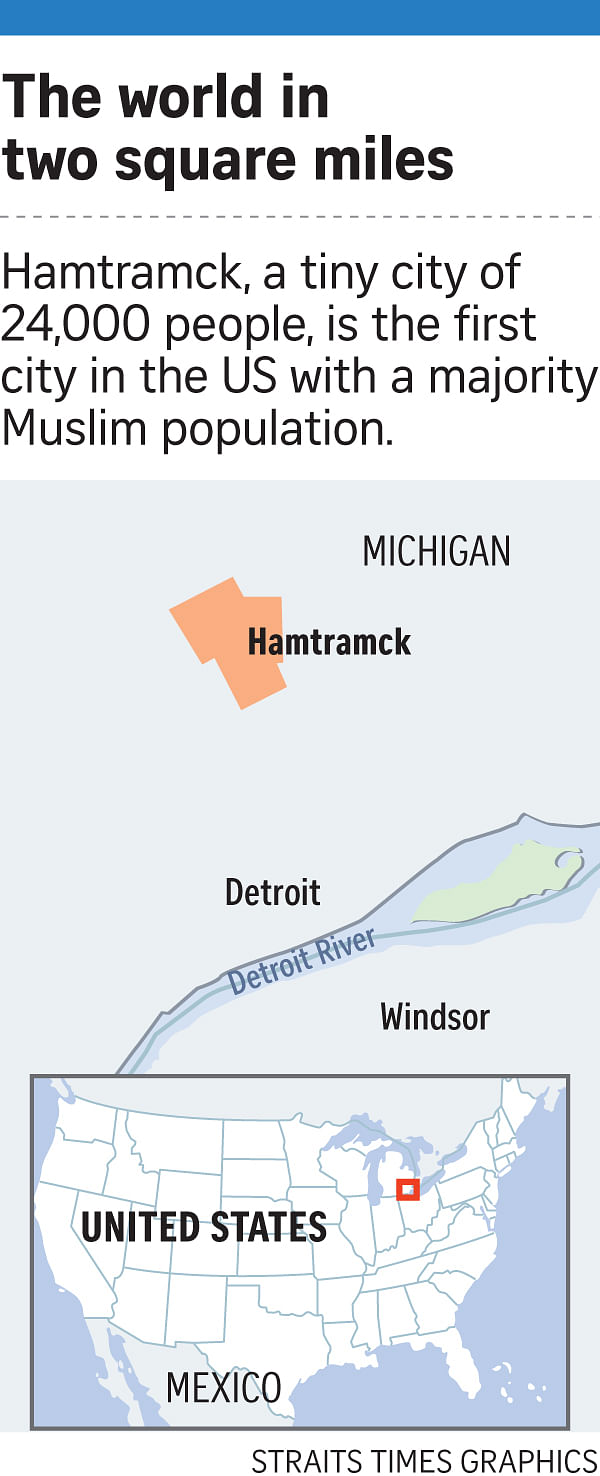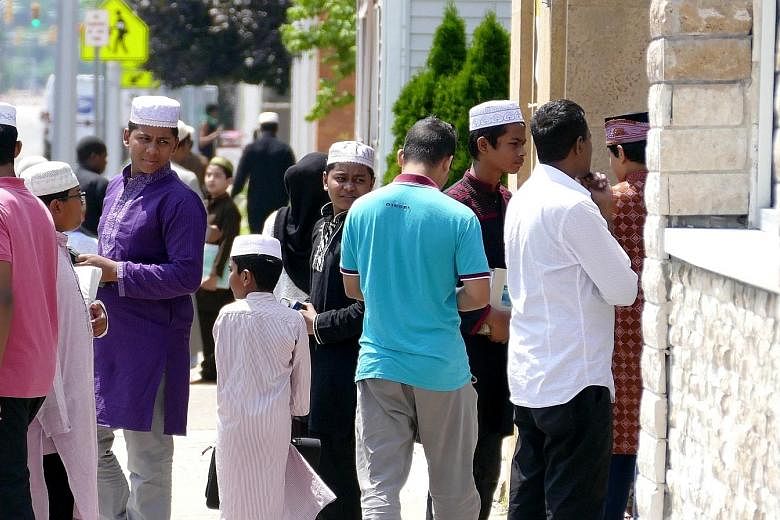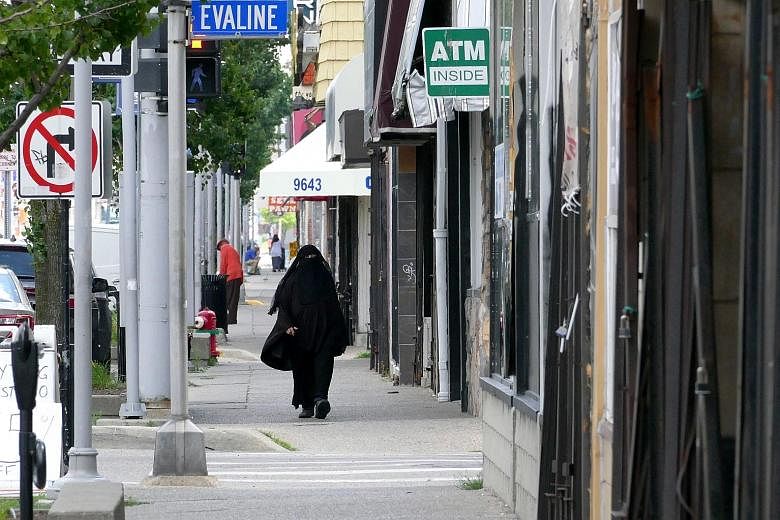Burqa-clad women walk down Joseph Campau Street, where the flags of half a dozen nations, from Bosnia to Bangladesh, flutter in the wind outside rows of houses and shopfronts.
"You see them? People come here from outside and they go crazy when they see this," said Mr Greg Kowalski, chairman of the Hamtramck Historical Commission.
The world in two square miles. That is how locals describe Hamtramck (pronounced "Hamtramick" - the name of the French-Canadian soldier who founded the town), one of America's most diverse cities and the first with a majority Muslim population.
The tiny city of 24,000 people in mid-western America first hit global headlines in 2004, when the town council amended noise laws to lower the volume of the call to prayer from the mosques, which proliferated with the arrival of more Muslim immigrants.
Along with the faces on the streets, the soundtrack of the city had shifted. Hamtramck's once-dominant Polish population was on its way to becoming a minority; today it is about 10 per cent. The biggest communities are Muslim ones from Yemen and Bangladesh.
In 2015, the town council became majority Muslim, triggering a second round of media frenzy. Some headlines even warned about the onset of syariah law.
But far from seething with conflict, Hamtramck is a colourful example of diversity and tolerance, and potentially a litmus test of change in America, a country formed by successive waves of immigrants.

The Polish Village restaurant bustles with customers well past lunch time, serving up kielbasa sausage and potato dumplings. Up the road and around the corner, the Royal Kabob fires up its first order of succulent halal lamb chunks.
A couple of blocks away, the Alladin Cafe serves hot samosas and Bengali-style fried fish and sweet tea to a hungry high-school group.
"Honestly, Hamtramck is one of the chillest and most comfortable cities I've ever lived in," music producer Joseph Martinez, 23, told The Straits Times, looking up from a book he was reading at Pope Park.
The small public park commemorates the visit to the city in 1987 by the Polish-born Pope John Paul II, who had a cousin in Hamtramck at the time.
Mr Martinez had only recently moved from Nashville, Tennessee, he said, where in July, the local Islamic centre was vandalised.
"Up here, they don't seem to be so on edge," he said. "For all the fear and paranoia that people have of the type of people who live here - Muslims and just immigrants in general - it's honestly the safest I've ever felt in a community. Everybody gets along pretty well."
PEACEFUL CO-EXISTENCE
Mr Salah Hadwan, a nurse, arrived in America from Yemen in 1994 at the age of five. He shook his head in disbelief when he recalled the alarm over the purported onset of syariah law in Hamtramck - and the vicious Facebook messages that were circulating at the time, including suggestions to "bomb Hamtramck".
"None of that, the syariah law, has happened. And it isn't going to happen," the 29-year-old said in an interview at a game parlour where young Yemeni lads played pinball and soccer games, and occasionally jived to rousing Arabic pop music.
"I don't see it happening; regardless of who is in this city, regardless of their background or religious beliefs, we are in the United States," he said.
Mr Hadwan is active in the community. He helped raise funds for Pope Park and for an old church, and is secretary of the local school board.
-
Muslim population set to expand in US
-
When it comes to political power, the tiny city of Hamtramck, Michigan - America's first Muslim-majority city and the first city with a Muslim-majority town council - is an exception.
The United States' Houses of Congress are 91 per cent Christian, just a little less than in 1961, when 95 per cent were Christian.
But nationally, America's demographic and religious landscape has changed under waves of immigration.
In January last year, the Pew Research Centre predicted that by 2040, Muslims would comprise the second-largest religious group in the US after Christians.
The organisation estimated that there were about 3.3 million Muslims of all ages living in the US, accounting for 1 per cent of the country's population. The share is projected to double by 2050, when the American Muslim population is expected to reach 8.1 million or 2.1 per cent of the total population.
Just over half of the growth of the American Muslim population from 2010 to 2015 was due to immigration, according to Pew.
But people identifying as Muslim are not equally distributed across the US; some states like New Jersey have two or three times as many Muslims as the national average.
Worldwide by 2050, the number of Muslims will nearly equal the number of Christians.
Nirmal Ghosh
Hamtramck is an example of peaceful coexistence, he said. But he was careful to qualify that.
"I don't want people to get the picture that we are a perfect community because no matter what community you live in, everyone has his own differences and beliefs," he told The Straits Times.
"Hamtramck is no different."
While the city, thus far, defies the stereotypical fears of conflict, there is nervousness among the immigrant community over the direction of the current US government.
When President Donald Trump announced a temporary travel ban in January on citizens from the largely Muslim countries of Iraq, Iran, Libya, Somalia, Sudan, Syria, and Yemen, and suspended the US' refugee programme, locals joined thousands around the country in mounting their own peaceful protest rally. That ban, and a subsequent one, were both stayed by federal courts, but in June, the Supreme Court allowed some provisions to go ahead.
SELF-FULFILLING PROPHECY
There has also been trepidation in the Polish community over the demographic shift, which has been evolving since the early 2000s.
But such shifts are not new. "Displacement is the story of America," said Mr Rashid Dar, who studies the US' relations with Islam at Washington's Brookings Institution.
"The idea of conflict and polarisation is the slogan of our age, so to speak," said Mr Dar.
"When we focus on Muslims in the West, the symbols of their identity become polarisers.
"The most prominent may be the burqa or halal meat. Muslims' ostensibly religious acts take on a political tone. A few well-placed stories can make people believe that we are in conflict, and it can then become a self-fulfilling prophecy."
Hamtramck was a German farming community when the Polish flocked in for jobs in the auto industry in the early 1900s, said the city's ethnic Polish mayor, Ms Karen Majewski.
The 62-year-old owner of a store selling vintage items from crockery to clothes laughed off complaints of Muslims "taking over".
"When the Poles came, we totally took over," she said in an interview at her shop.
"In Hamtramck, we are so physically close to each other that we hear each other, we smell each other's food, we see other's signs in different languages, unlike in a typical suburb, where you would drive into your garage and go directly into your house and sit in your fenced backyard, sometimes without even knowing your neighbour."
Ms Majewski, who has studied immigration and ethnicity, said: "There are challenges, but for the most part, we live with each other and people basically get along with their neighbours until they take their parking places or something and they complain - which is nothing to do with ethnicity."
Hamtramck Historical Commission's Mr Kowalski, 66, was born in Hamtramck and will never leave, he told The Straits Times.
"We have about 20 per cent Bangladeshis, 20 per cent African Americans, 20 per cent from Yemen, and everybody else is here; there's a Filipino community, there are Germans, Russians, Bosnians, Croatians, Serbians," he said.
"We have a bit of everything and it's a lot for two square miles.
"There's always going to be some degree of tension whenever you have change, but it is not overwhelming, and it is not nearly as much as some people who don't live here think it is.
He assured: "It's not unusual or scary."
"We get more critics and concern from people about life here who don't live here. We know how to live here," he added.




